Utah Olympic Park
The Utah Olympic Park is a winter sports park built for the 2002 Winter Olympics, and is located 28 miles (45 km) east of Salt Lake City near Park City, Utah, United States. During the 2002 games the park hosted the bobsleigh, skeleton, luge, ski jumping, and Nordic combined events.[1] It still serves a training center for Olympic and development level athletes. Other facilities in addition to the ski jumps and bobsled track located on site include a 2002 Winter Olympics and Ski Museum, day lodge, summer aerial training splash pool, ziplines, and a mountain coaster.
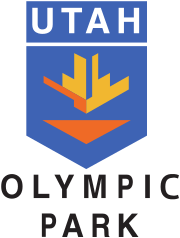 | |
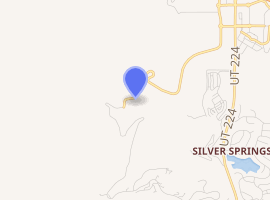
| |
| Former names | Utah Winter Sports Park |
|---|---|
| Location | 3419 Olympic Parkway Park City, Utah, United States |
| Coordinates | 40.71207°N 111.56193°W |
| Owner | Utah Athletic Foundation |
| Type | Winter Sports Park |
| Construction | |
| Built | 1991-1997 |
| Opened | January 9, 1993 (Ski jumps) January 25, 1997 (Track) |
| Expanded | 1998-2001 |
| Website | |
| Utah Olympic Park | |
Park history
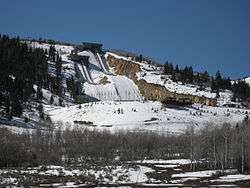
Like the Utah Olympic Oval and Soldier Hollow, the park was designed and built specifically for the Olympic games, under the supervision of the Salt Lake Organizing Committee (SLOC). The 1989 Olympic referendum, which was passed by Utahns, allowed for tax payer money to fund a winter sports park, which would be used if Salt Lake City won its bid for either the 1998 or 2002 Winter Olympics; Olympic funds and revenue would then be used to repay the state. In 1990 the Utah Sports Authority announced their plans to build the park, which included ski jumps and a bobsled-luge track, in Bear Hollow near Park City.[2] Before construction on the park began, it faced criticism from local landowners and citizens of Summit County, concerned over traffic and environmental effects.[3] Construction got underway following a groundbreaking ceremony on May 29, 1991. The original estimated cost of the park was $26.3 million and included the ski jumps, bobsled-luge track, and a day lodge, all to be completed by September 1992.[4] The majority of the park was designed and engineered by Eckhoff, Watson and Preator Engineering and its joint venture partner, Van Boerum & Frank Associates, all of Salt Lake City.[5]
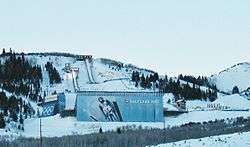
After Salt Lake City lost its bid to host the 1998 Winter Olympics in 1991, the Utah Sports Authority gained permission from the United States Olympic Committee (USOC) to slowdown construction on the park, extending its planned opening date.[6] Four of the park's ski jumps (18, 38, 65 and 90 meters) were completed and opened on December 12, 1992, and were formally dedicated in a ceremony on January 9, 1993.[7] On July 31, 1993 the summer training facilities at the park, which included a ski jumping pool, were dedicated.[8] The park's day lodge, located near the base of the jumps, was completed in late summer 1993.
A groundbreaking ceremony on June 3, 1994 signaled the start of construction on the bobsled-luge track.[9] The track was completed December 28, 1996 and its grand opening ceremony was held on January 25, 1997. The very first run on the new track was by luger Jon Owen on January 10, 1997.[10] Following the completion of the track it was decided to reintroduce skeleton as an Olympic event during the 2002 Winter Olympics and plans called to use the track to host all three sliding events.
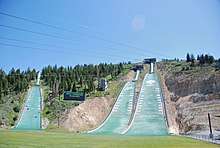
While construction was progressing on the track, Salt Lake City won its 1995 bid to host the 2002 Winter Olympics, and plans were developed to expand the park. On October 9, 1997 SLOC okayed the plan to spend an additional $48 million to upgrade and expand the recently completed park. The plans called for replacing and moving the existing 90-meter ski jump, and building a brand new 120-meter jump. Also the construction of starting houses on the track, chairlifts, storage buildings, new access roads, pedestrian bridges, parking lots, and sewer and water lines were all part of the expansion plan.[11] The transform of the park began during the Summer of 1998, with the majority of expansion work completed by fall 2000. Ownership of the park was transferred from the Utah Sports Authority to SLOC on July 14, 1999.[12] Soon after, in Spring 2000, the name "Utah Winter Sports Park" became the "Utah Olympic Park'.
The park today
The park still serves a training center for Olympic and development level athletes, as well as a recreational highlight in the state. Other facilities in addition to the Nordic jumps and bobsled track located at the park include a 2002 Winter Olympics Museum and Ski Museum in the Joe Quinney Winter Sports Center, a day lodge, summer aerial training jumps and splash pool, ziplines, and a mountain coaster.
Joe Quinney Winter Sports Center
Located within the Utah Olympic Park is the Joe Quinney Winter Sports Center. The center stands next to the day lodge and summer splash pool.
History
For many years the Alf Engen Ski Foundation had desired to construct a museum to honor legendary skier Alf Engen, and display his winter sports collection. It was decided to do this inside a future building at the park, also named for a skier, Joe Quinney. A site dedication ceremony for the privately funded Joe Quinney Winter Sports Center was held August 28, 1999,[13] while construction didn't begin until after the actual groundbreaking on March 28, 2000. Following the building's completion, it was temporarily turned over to SLOC during a ceremony on September 18, 2001. During the games the center would be used by Olympic officials, members of the world media and athletes, then after the games, the building would be turned back over to the foundation. The cost of just the vacant building was $10 million, the majority of which was privately funded, but SLOC did contribute a percentage of construction costs so the building could be used during the games. The completed building was 29,000 square feet (2,700 m2) in size with three stories, and its concrete exterior was covered with Plexiglas (various figures and designs were etched into the Plexiglas).[14]

Following the Olympics the building was turned into a ski and Olympic museum at a cost of $2.5 million more, for a total of $12.5 million. The Alf Engen Ski Museum opened in a soft opening on May 20, 2002, with exhibits designed by Academy Studios.[15] The grand opening ceremony for the center was held July 5, 2002, and the building included the Engen Ski Museum, a gift shop, café and a temporary Olympic photo exhibit (which would be replaced by a new Olympic museum in later years).[16]
On September 27, 2002, two life-sized statues of Alf Engen and Joe Quinney were unveiled in the Olympic plaza near the building.[17] In May 2004 the Alf Engen Ski Foundation sold the center to the Utah Athletic Foundation, who owns and operates the surrounding Utah Olympic Park.[18] In early June 2005 the temporary 2002 Olympic Photo Exhibit was replaced with a new permanent Olympic museum. An opening celebration for the officially titled "George Eccles Salt Lake 2002 Olympic Winter Games Museum" was held June 9, 2005.[19]
Exhibits
The center houses two museums, the Alf Engen Ski Museum and the George Eccles Salt Lake 2002 Olympic Winter Games Museum. The Ski Museum contains more than 300 trophies, medals, uniforms, scrapbooks, skis, boots, photos, films and other collectibles that span some 70 years in the career of the Engen family. It also highlights Utah's rich ski history and the Wasatch Range, along with efforts made by the U.S. Forest Service to help develop Utah's ski resorts, and an exhibit on Utah's winter weather.[20]
The 2002 Winter Olympic Museum, currently located on the second floor of the center, includes athletic equipment used during the games, Olympic medals (and a display on how they were created), costumes and puppets used during the ceremonies, many of the officially licensed pins produced for the games, a photo op at an Olympic torch mounted in front of a large photo of the cauldron, along with video clips and other memorabilia.[21]
Notes
- Salt Lake Organizing Committee (2001). Official Spectator Guide. p. 74.
- Joel Campbell (29 June 1990). "Summit County likely will win Olympics Prize: A Sports Park". Deseret News. Retrieved 15 December 2010.
- Joel Campbell (10 October 1990). "Summit Landowner files lawsuit to derail Olympic Sports Park". Deseret News. Retrieved 15 December 2010.
- Lisa Riley Roche (29 May 1991). "Winter Sports Park gets underway". Deseret News.
- Roger Pusey (8 January 1993). "Sports Park ready for dedication - at last". Deseret News. Retrieved 26 December 2010.
- Lisa Riley Roche (4 November 1991). "USOC approves slowdown on facilities". Deseret News. Retrieved 15 December 2010.
- Joel Campbell (10 January 1993). "Utah Officials hail opening of Ski Jumps". Deseret News. Retrieved 15 December 2010.
- "Ski Jumping is hot (and wet) at Sports Park". Deseret News. 1 August 1993. Retrieved 15 December 2010.
- Lisa Riley Roche (4 June 1994). "Hopes are high for 2002 at track groundbreaking". Deseret News. Retrieved 15 December 2010.
- Utah Athletic Foundation (2007). "Bobsled/Luge/Skeleton Track". Utah Athletic Foundation website. Retrieved 14 December 2010.
- Mike Gorrell (10 October 1997). "Olympic Funds: the Vote, the Veto; Trustees Elect to Spend $48 Million on Sports Park Upgrade". The Salt Lake Tribune.
- Mike Gorrell (15 July 1999). "Winter Sports Park Becomes SLOC Facility". The Salt Lake Tribune.
- Ray Grass (24 August 1999). "Groundbreaking set for sports center, museum". Deseret News. Retrieved 15 December 2010.
- Ray Grass (19 September 2001). "SLOC accepts use of center". Deseret News. Retrieved 15 December 2010.
- Ray Grass (4 June 2002). "Center, museum open quietly". Deseret News. Retrieved 15 December 2010.
- Ray Grass (6 July 2002). "Engen museum opens doors". Deseret News. Retrieved 15 December 2010.
- Ray Grass (30 September 2002). "Ski Hall of Fame inducts 8". Deseret News. Retrieved 15 December 2010.
- Alf Engen Ski Museum Foundation (2010). "History". Alf Engen Ski Museum website. Archived from the original on 22 December 2010. Retrieved 16 December 2010.
- Mike Gorrell (9 June 2005). "New museum recaptures magic of the 2002 Games". The Salt Lake Tribune.
- Alf Engen Ski Foundation. "Alf Engen Ski Museum Exhibits". Alf Engen Ski Museum Museum Foundation website. Archived from the original on 22 December 2010. Retrieved 23 December 2010.
- Alf Engen Ski Museum Foundation. "George Eccles 2002 Olympic Winter Games Museum Exhibits". Alf Engen Ski Museum Foundation website. Archived from the original on 9 February 2009. Retrieved 23 December 2010.
External links
| Wikimedia Commons has media related to Utah Olympic Park. |
- Utah Olympic Park - Official website
- Alf Engen Ski Museum - Official Website

